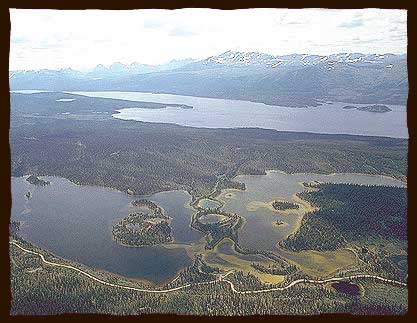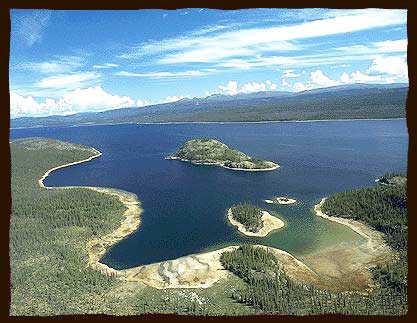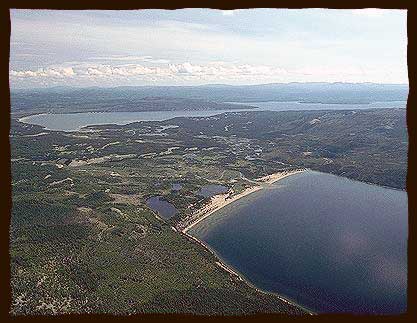Aishihik
Äshèyi – Aishihik
Southern Tutchone
Dän k’è Aishihik, Äshèyi kùye ch’e. Ätl’a dhäl lan kwä̀’ą kā kwäni. Äshèyi Mǟn kay łu ätlą kwä̀ch’e. Nena shų ätlą kùlį. Äshèyi Mǟn ts’ųts’än tän kwäzhät kwä̀nn’a’, ätl’a Klukwan ts’än ä́dè Selkirk kwäts’ä̀n kwä̀dą. Ätl’a Älǖr dädáta yè tä̀nadä̀l k’e ń-łäyè nä̀nadä̀l nų̄.
Äshèyi kwädǟn, Tthe Yänlin yè Dakwä̀kä̀da ts’ä̀n ń-dä̀nijēl nà, ätl’a gúch’än Äshèyi airport kàdàdinńkyǖ k’e. Äk’ān k’e Äshèyi kwädǟn däkeyi łänadä̀l k’e kų̀ ghànakwä̀tsi.
English
The old Southern Tutchone name for Aishihik is Äshèyi. One interpretation of the name is “at the end (or tail) of the mountain range”, referring to the village site at the north end of the lake. Another Southern Tutchone name for the lake is Män Shäw, or “Big Lake”. Some traditional Aishihik people had names such as “Big Lake Joe”, “Big Lake Albert”, etc.
The old and new Aishihik villages are at the north end of the lake on a shallow bay. The location is good because it is out of the wind and fish come to spawn in the shallow water. There is good hunting in the surrounding area. At one time the caribou hunting was especially good. People would travel in all directions hunting and fishing on their seasonal rounds, always returning to the village headquarters. There are two cemeteries overlooking the present village, and two lying to the north and west.
At the old village site artifacts have been found which show trade contact with Tlingit, White River Upper Tanana, and Europeans. Glass beads, engraved Tlingit mother-of-pearl buttons, cartridges, dentalium shells and a copper arrow point have come to light.
The road to Aishihik village runs north along the east side of Män Shäw, but the main traditional trail from the south ran along the west side of the lake to Äshèyi then north to Fort Selkirk on the Yukon River. There was a trail on the east of the lake but it ran to Long Lake and Hutshi. Besides trails north to the Yukon River, south to Klukwan, and east to Hutshi, there were trails west to Kluane Lake and northwest to the Nisling River. When the Tlingit began coming far inland to trade, local people acted as guides and middle men between the Chilkat from the south and the Northern Tutchone to the north.
A typical situtation was that of Gòłan, a coastal Tlingit who came north trading as a young man. At Selkirk he met Mằdằka and wanted to marry her and take her home. The Selkirk people would not let her go, so he returned to Klukwan. The next year he came to Selkirk with presents for her parents, but they still would not let her move to the coast. Instead, as a compromise, they let her move to Aishihik where she had relatives and would be closer to Gòłan. Then Gòłan also decided to stay at Aishihik. They had one child, Isaac Chief, who survived to adulthood. His son was Chief Isaac of Aishihik. Memories of Gòłan and Mằdằka remain strong in both Äshèyi and Klukwan traditions. As late as the 1940’s and 1950’s, Aishihik and Klukwan families were spending time together.
The US army constructed an airport at Aishihik during the building of the Alaska highway. The Department of Transport maintained the airport until the 1960’s. At that time the Federal Department of Indian Affairs told the Aishihik people that the road would no longer be maintained and they would no longer receive rations or schooling for the children. To encourage them to move, Indian Affairs built housing at Canyon. Most people moved there or to Haines Junction.
The road is still open today. Two families live year-round in the village and about twenty houses are in seasonal or weekend use. Many Äshèyi people who work in Whitehorse or Haines Junction return to the village almost every weekend.



